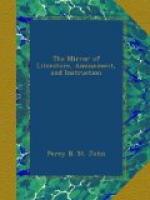To the many improvements which have already taken place in the neighbourhood of London, another will shortly be added; a suspension-bridge, intended to facilitate the communication between Hammersmith and Kingston, and other parts of Surrey. The clear water-way is 688 feet 8 inches. The suspension towers are 48 feet above the level of the roadway, where they are 22 feet thick. The roadway is slightly curved upwards and is 16 feet above high water, and the extreme length from the back of the piers on shore is 822 feet 8 inches, supporting 688 feet of roadway. There are eight chains, composed of wrought-iron bars, each five inches deep and one thick. Four of these have six bars in each chain; and four have only three, making thirty-six bars, which form a dip in the centre of about 29 feet. From these, vertical rods are suspended, which support the roadway, formed of strong-timbers covered with granite. The width of the carriageway is 20 feet, and footway five feet. The chains pass over the suspension towers, and are secured to the piers on each shore. The suspension towers are of stone, and designed as archways of the Tuscan order. The approaches are provided with octagonal lodges, or toll-houses, with appropriate lamps and parapet walls, terminating with stone pillars, surmounted with ornamental caps. The whole cost of this remarkable object, displaying the great superiority acquired by British artisans in the manufacture of ironwork, is about 80,000l. The advantages to be derived from this bridge in the saving of distance, will be a direct passage from Hammersmith to Barnes, East Sheen, and other parts of Surrey, without going over either Fulham or Kew bridges.
The annexed engraving may be consulted, in illustration of the foregoing remarks, as it is a correct and perfect delineation, having been taken from an original sketch made by our artist on the spot.
* * * * *
THE MONTHS.
* * * * *
REAPING IN DEVONSHIRE.
As an illustration of a prevailing harvesting custom, peculiar to more counties than one at this season, and at the opening of this month, we subjoin the following letter which appeared in vol. xxxvii. of the Monthly Magazine:—
The reaping and harvesting of the wheat is attended with so heavy an expense, and with practices of so disorderly a nature, as to call for the strongest mark of disapprobation, and their immediate discontinuance, or at least a modification of the pastime after the labours of the day. The wheat being ready to cut down, and amounting from ten to twenty acres; notice is given in the neighbourhood that a reaping is to be performed on a particular day, when, as the farmer may be more or less liked in the village, on the morning of the day appointed a gang, consisting of an indefinite number of men and women assemble at the field, and




